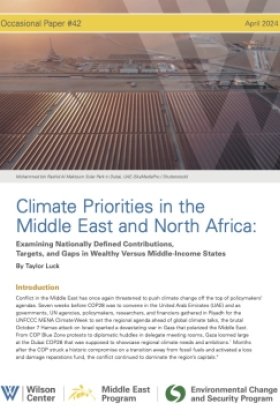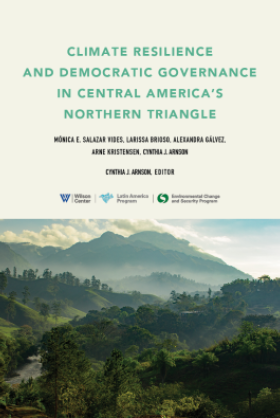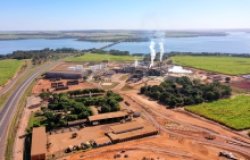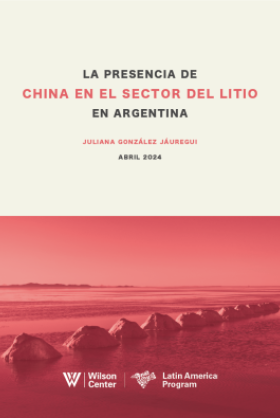Political Instability Task Force: New Findings
Professors Jack Goldstone, Robert Bates, and Colin Kahl discuss the Political Instability Task Force's efforts to develop a global statistical model for assessing states' vulnerability to political instability.
Overview
Professors Jack Goldstone, Robert Bates, and Colin Kahl presented the Political Instability Task Force's latest findings at a February 5th meeting co-hosted by the Environmental Change and Security Project and the Conflict Prevention Project. The speakers provided an overview of the fourth phase of the Task Force's efforts to develop a global statistical model for assessing states' vulnerability to political instability. They provided details on an additional sub-Saharan Africa model and on the role of population and environment variables in their work.
The Political Instability Task Force (formerly known as the State Failure Task Force) seeks to identify factors that increase a state's vulnerability to political instability over a six-month to two-year period. The Task Force's work focuses on four types of acute instability: revolutionary war; ethnic war; adverse regime change, including the collapse of central state authority, the dissolution of a federated state, or a reversal of democracy; and genocide or politicide. The Task Force has identified more than 250 historical instances of acute instability occurring between 1955 and 2002, most of which involved combinations or sequences of the above types of events.
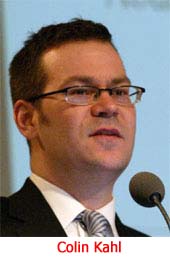 After testing scores of political, demographic, economic, and environmental factors, the Task Force found that the character of a country's political institutions plays a crucial role in determining vulnerability to political stability. Put simply, certain types of regimes are far more vulnerable than others. Weak democracies—electoral regimes exhibiting winner-take-all competition between parochial factions and placing limited checks on executive authority—were as much as 30 times as likely to experience instability as stronger democracies or closed autocracies. Autocracies with some political competition were found to be eight times as vulnerable. The Task Force also found that, although dwarfed by the impact of political institutions, official discrimination, high infant mortality (which the authors surmised was a proxy for the level of material well-being), the "bad neighborhood" effect of conflicts in bordering countries, and low levels of trade openness, also significantly increase the risk of political instability. The speakers concluded that the single most important way to avoid instability was to get the institutions right. In the long term, however, material well-being also matters, and once countries are rich and democratic, they nearly always remain stable.
After testing scores of political, demographic, economic, and environmental factors, the Task Force found that the character of a country's political institutions plays a crucial role in determining vulnerability to political stability. Put simply, certain types of regimes are far more vulnerable than others. Weak democracies—electoral regimes exhibiting winner-take-all competition between parochial factions and placing limited checks on executive authority—were as much as 30 times as likely to experience instability as stronger democracies or closed autocracies. Autocracies with some political competition were found to be eight times as vulnerable. The Task Force also found that, although dwarfed by the impact of political institutions, official discrimination, high infant mortality (which the authors surmised was a proxy for the level of material well-being), the "bad neighborhood" effect of conflicts in bordering countries, and low levels of trade openness, also significantly increase the risk of political instability. The speakers concluded that the single most important way to avoid instability was to get the institutions right. In the long term, however, material well-being also matters, and once countries are rich and democratic, they nearly always remain stable.
The Task Force has also developed a model specific to sub-Saharan Africa, where 35% of the world's instability events have occurred in the past 50 years, more than any other region. This regional model returned results quite similar to the global one, demonstrating that political institutions are the most influential risk factor in Africa, as they are in the rest of the world, and that official discrimination, conflict in bordering states, and low trade openness also increase the risk of instability in this fragile region. In contrast to the global model, however, the Task Force also found that states with new or entrenched leaders and those formerly colonized by countries other than France were more vulnerable to instability. Contrary to some previous research—and surprising to many Task Force members—the Task Force did not find significant effects from ethnic diversity, youth bulge, or an abundance of natural resources.
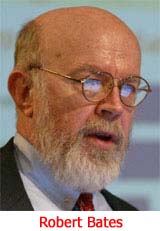 The last speaker analyzed two schools of thought about the relationship between environment and conflict in light of the Task Force's findings. On one hand is the scarcity/grievance approach, which posits that population and environmental pressures produce social grievances and strains on political institutions that increase the risk of instability. On the other hand is the abundance/greed argument, which posits that local abundances of natural resources increase the risk of instability by providing opportunities for groups to finance or profit from rebellion. The Task Force's analysis found little evidence to support either theory, although its finding on infant mortality is consistent with the scarcity/grievance school. In the Task Force's view, population, environment, and resource pressures are neither universally necessary nor wholly sufficient causes of violent political instability. The Task Force also acknowledged, however, that a lack of accurate historical data on environmental change, the focus in its analysis on state-level characteristics, and the high threshold for qualifying events (1,000 deaths overall and at least 100 deaths in one year) make it difficult to test definitively these arguments, and the Task Force plans to continue investigating these relationships.
The last speaker analyzed two schools of thought about the relationship between environment and conflict in light of the Task Force's findings. On one hand is the scarcity/grievance approach, which posits that population and environmental pressures produce social grievances and strains on political institutions that increase the risk of instability. On the other hand is the abundance/greed argument, which posits that local abundances of natural resources increase the risk of instability by providing opportunities for groups to finance or profit from rebellion. The Task Force's analysis found little evidence to support either theory, although its finding on infant mortality is consistent with the scarcity/grievance school. In the Task Force's view, population, environment, and resource pressures are neither universally necessary nor wholly sufficient causes of violent political instability. The Task Force also acknowledged, however, that a lack of accurate historical data on environmental change, the focus in its analysis on state-level characteristics, and the high threshold for qualifying events (1,000 deaths overall and at least 100 deaths in one year) make it difficult to test definitively these arguments, and the Task Force plans to continue investigating these relationships.
Although the Political Instability Task Force is funded by the Central Intelligence Agency, its reports and presentations do not represent the official view of the U.S. Government, the U.S. intelligence community, or the Central Intelligence Agency, but rather the views of the individual authors.
Speakers

Colin Kahl

Jack A. Goldstone
Virginia E. and John T. Hazel Professor of Public Policy, George Mason University; Wilson Center Fellow
Robert Bates
Hosted By

Environmental Change and Security Program
The Environmental Change and Security Program (ECSP) explores the connections between environmental change, health, and population dynamics and their links to conflict, human insecurity, and foreign policy. Read more
Thank you for your interest in this event. Please send any feedback or questions to our Events staff.
